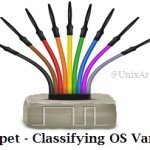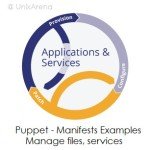Define all your IT infrastructure as Code instead of creating it manually. So that Infrastructure resources can be easily re-created or replicated. Managing IT infrastructure might be a hard job in the past but not now. In the past, system administrators have to manually manage and configure all of the hardware and software that was […]
Puppet
Puppet – Puppet Forge Modules – Overview
Puppet forge is a module repository for Puppet Open Source and Puppet Enterprise IT automation software. These modules are written by puppet community members and puppet reviews the module before publishing it. Puppet also supports many of modules in this repository. Why do we require pre-built puppet modules ? To simply system administrator work and […]
Puppet – How to Classify the Node types ?
We need to classify the nodes when you have to perform similar operation on different OS variant. For an example, If you want to install Apache package on Linux systems, you need to use package name as “httpd” on Redhat variants and “apache2” on Debian variants. In such a cases, you need to tweak your module […]
Puppet – Augeas – Edit System configuration files
This article is going to demonstrates that editing/updating files on puppet agent nodes. In the previous article , we have seen that how to copy the static files from “module/files” directory(Puppet Server) to puppet agent nodes. But sometimes , you can’t replace the complete file and you may need to edit specific line on that. For example […]
Puppet – Manifest examples – Managing FILES – SERVICES
This article is going to brief about creating new files , directories, changing the file permission, installing package and managing the services using puppet server on puppet agent nodes. For an example, if you want to configure the ntp client on 100’s of servers , you could simply write a small manifest on puppet server […]
Puppet – Writing a First Manifest – Modules
It’s time to write first manifest on the puppet server. This article is going to brief about writing a custom puppet script to automate the installation of httpd/Apache package on Linux servers. Similar way you can automate package installation, updating files, configuring services and many more. Resources are defined using resource declaration syntax and stored […]
Puppet Server – Code and Configuration Directories
This article will brief about the puppet server’s directory architecture and important configuration files. We can classify the puppet server directories as 1. Code Directory and Data Directory 2. Config directory. Puppet’s code directory is a main directory to store the code and data. It contains environments which stores manifests and modules. Manifest directory contains site.pp and nodes.pp […]
Puppet – Resource Declaration – Overview
Resources are essential unit to perform the system configuration. Each resource will describe the particular thing in puppet. For an example, specific user needs to be created or specific file needs to be updated across the puppet agent nodes. When you would like to manage the users, “user” resource type will come in to play. If you want […]
Puppet – What is Facter ? How it works ?
This article is going to brief about Puppet’s Facter. It’s a cross platform system profiling library which helps to provide the similar formatted output on all the operating systems. Puppet agent uses facter to send the node information to the puppet server and this is required when you compile the node’s catalog. Facter system profiling library is part of […]
Puppet – How to install and configure Puppet Agent (Client) ?
Once you have configured the Puppet Server, you can start adding the puppet agents to it. This article will brief about installing and configuring the puppet agent on Linux systems (RHEL 7 and Ubuntu 14.04). Puppet agents are nothing but the client machines which will regularly pulls configuration catalogs from a Puppet master and applies them […]









